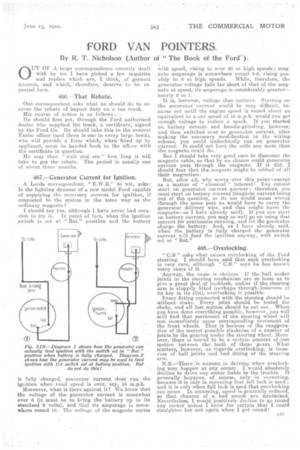FORD VAN POINTERS.
Page 29

If you've noticed an error in this article please click here to report it so we can fix it.
By R. T. Nicholson (Author of "The Book of the Ford' ).
OUT OF A large correspondence recently dealt with by me I have picked a few inquiries and replies which are, I think, of general interest, and which, therefore, deserve to be repeated here.
466. —That Rebate.
One correspondent asks what he should do to recover the rebate of import duty on a ton truck. His course of action is as follows :— He should first get, through the Ford authorized dealer who supplied the truck, a certificate, signed by the Ford Co. He should take this to the nearest Excise officer (and there is one in every large town), who will provide a form which, when filled up by applicant, must be handed back to the officer with the certificate in question.
He may then "wait and see" how 'long it will take to get the rebate. The period is usually one ef about three months.
467.—Generator Current for Ignition.
A Leeds correspondent, " E.W.R." to wit, asks: Is the lighting dynamo of a new model Ford capable of supplying the necessary -current for ignition, if connected to the system in the same way as the ordinary magneto?
I should say yes, although I have never had occasion to try it. In point of fact, when the ignition switch is set at "Bat." position and the battery is fully charged, generator current does run the ignition when road speed is over, say, 10 m.p.h.
Moreover, what is there against it ? We know that the voltage of the generator current is somewhat over 6 (it must be to bring the battery up to its standard 6 volts), and that its amperage is somewhere round 10. The voltage of the magneto varies with speed, rising to over 20 at high speeds; mag neto amperage is somewhere round 5-6, rising pos sibly to 8 at high speeds. While, therefore, the generator voltage falls far short of that of the magneto at speed, its amperage is considerably greater— nearly 2 to 1.
It is, however, voltage that matters. Starting on the generator current would be very difficult, because not until the engine speed is round about an equivalent to a car speed of 10 m.p.h. would you get enough voltage to induce a spark. If you started on battery current and handle-grinding, however, and then switched ovet to generator current, after making the necessary modification in the wiring scheme, you could undoubtedly run on generator current. It could. not hurt the coils any more than the magneto: could do.: But I should take very good care to dismount the magneto cable, so that by no Chance could generator current pass through the magneto. If it did, I should fear that the magnets might be robbed of al! their Magnetism.
But, after all, why worry over this point—except as a matter of "classical interest You cannot start on generator current anyway • therefore, you must start on battery current (magnetocurrent being out of the question, as its use would mean wiring through the same post as would have to carry the generator delivery wire, and that might harm the magneto—as I have already said). If you can start on battery current, you may as well go on using that .current for continuous running, and let the generator charge the battery. And, as I have already said, when the battery is fully charged the generator current will feed the ignition anyway, with switch set at "Bat."
468.—Overlocking.
" C.S." asks what causes overlooking of the Ford steering. I should have said that such overlockieg is very rare, although " U.S." says he has known many eases of it.
'Anyway, the cause in obvious. If the ball socket joints in the steering mechanism are so loose as to give a great deal of backlash, and/or if the steering arm is sloppily fitted (perhaps through.looseness of its key in its slot), overlocking is possible.
Every fitting connected with the steering should be without shake. Every joint should,. be tested for shake and all hest motion should be' cut out. When you have done everything possible, however, you will still find that movement of the steering wheel will not iestmediagely cause corresponding movement of the front wheels. That is because of the exaggeration of the merest possible stackness of a number of joints by the gearing under the steering wheel. More over, there is bound to be a. certain amount of .lost motion .between the teeth of those gears. What matters however, as regards. overloeking, is looseness of. 'hail joints and :bad fitting or the steering arm. .
N.B.—There is DANGER, in driving when overlocking may happen at any corner. I would absolutely decline to drive any motor liable to the trouble. It generally happens, of course, only in cornering, because it is only in cornering that full lock is used; and it is only when full lock is used that overlocking can occur. In cornering, speed is generally reduced-, so that chances of a bad. smashare minimized. Nevertheless, I would positively decline to go round any corner. unless I knew for certain that I could straighten her out again when I got round!


































